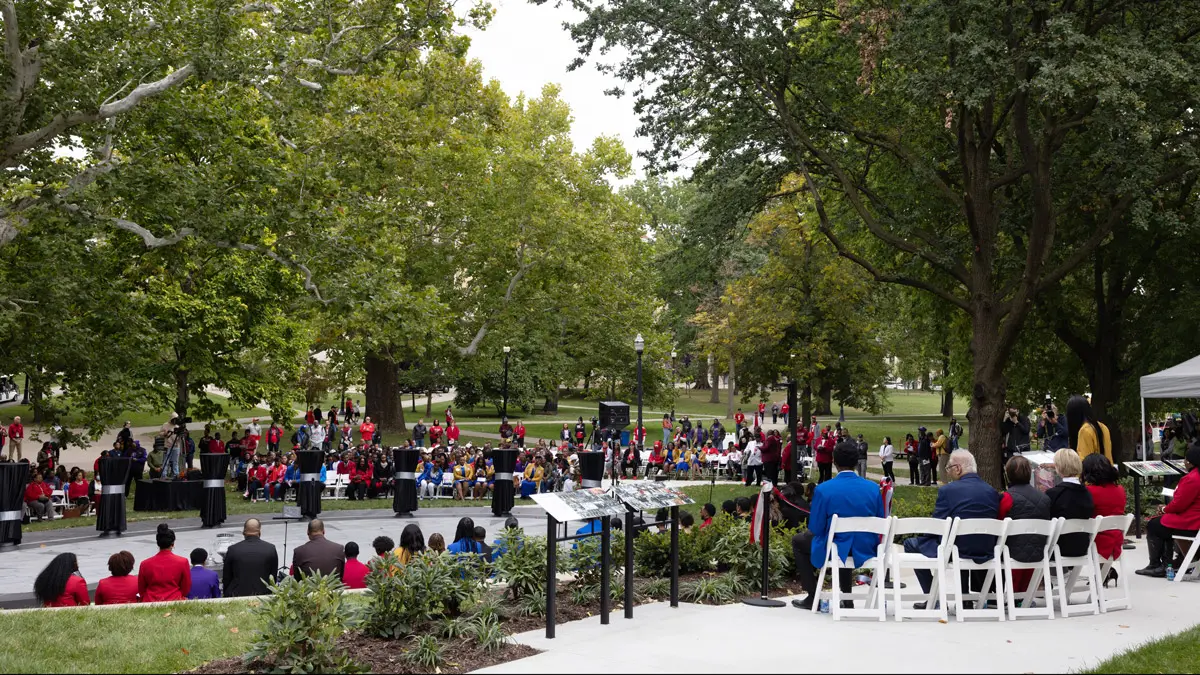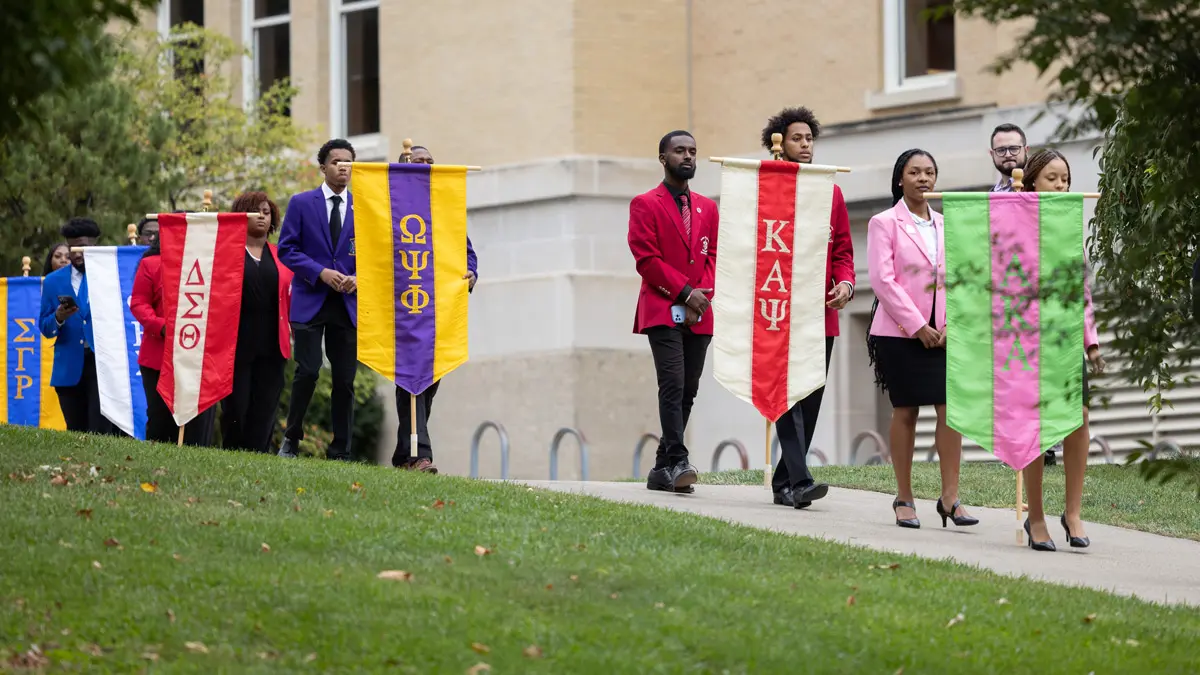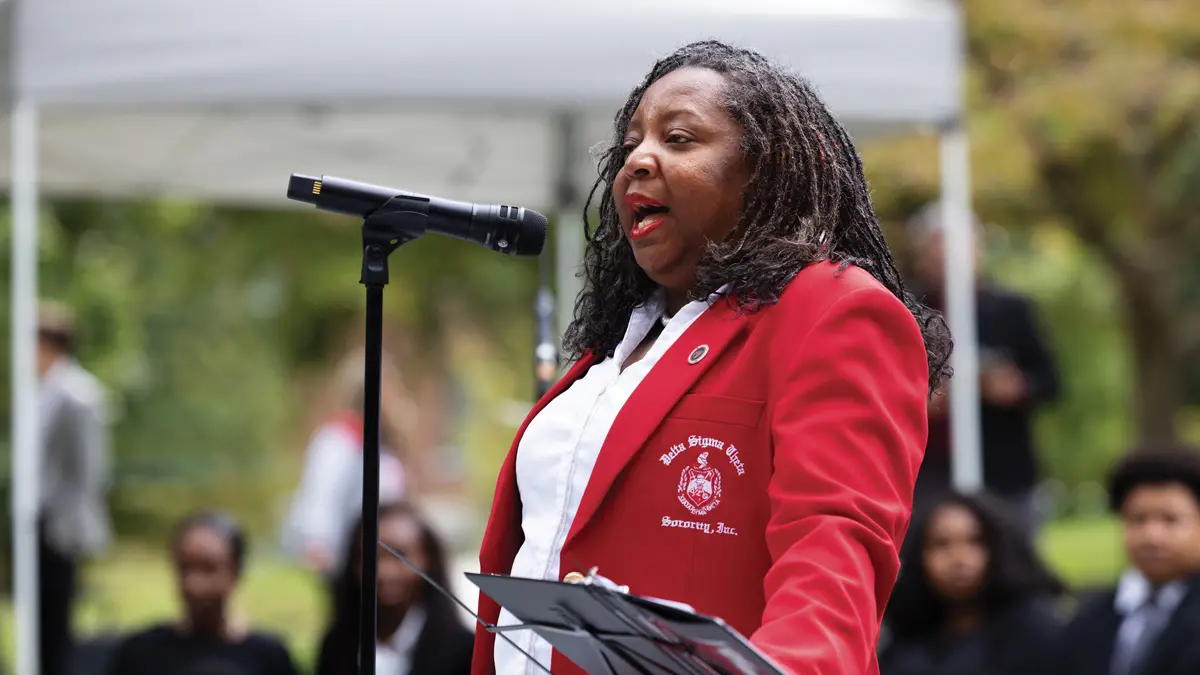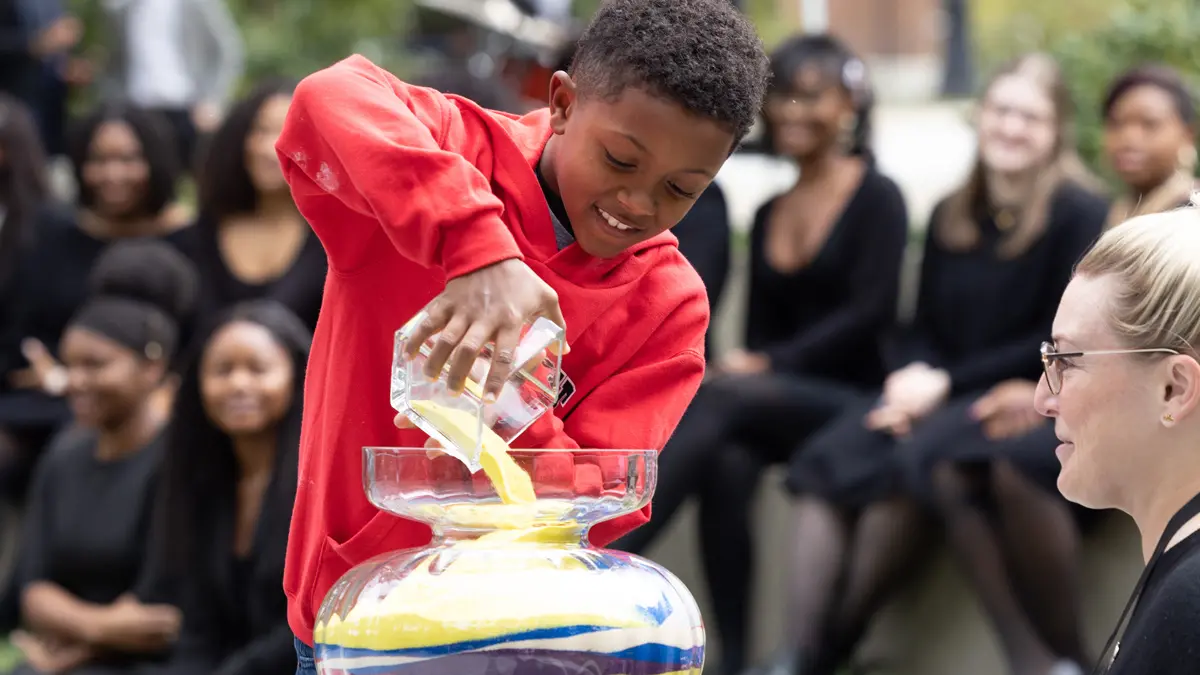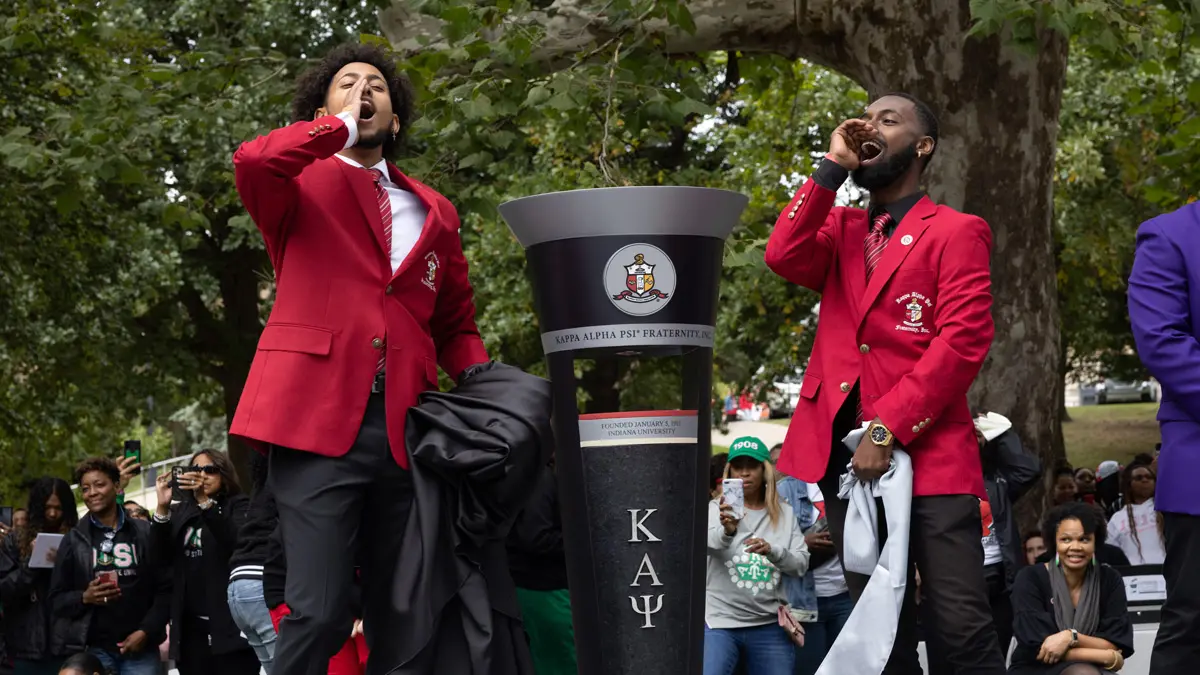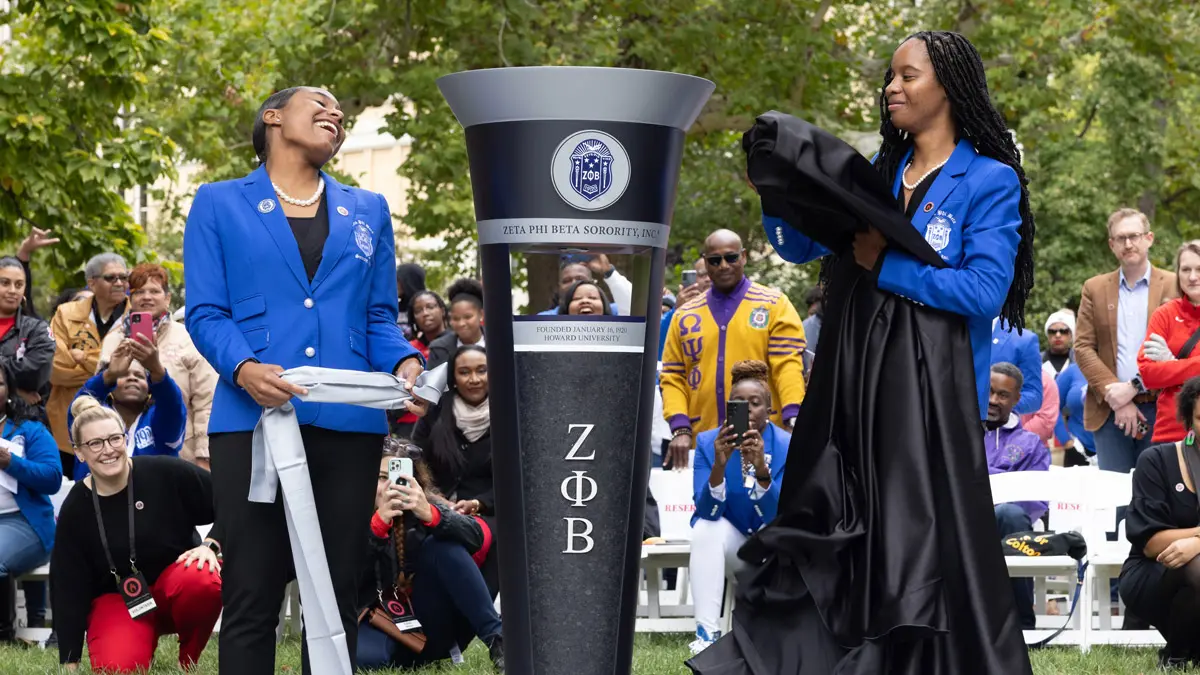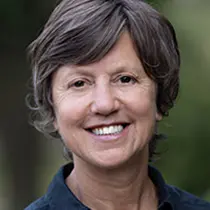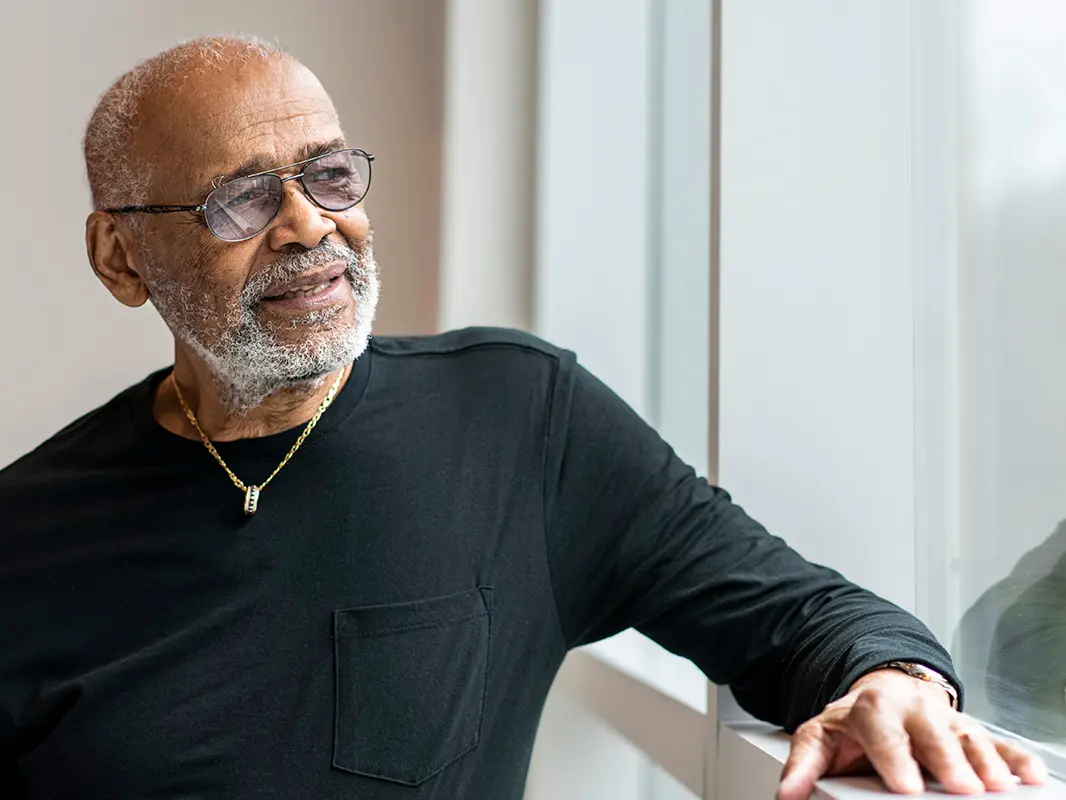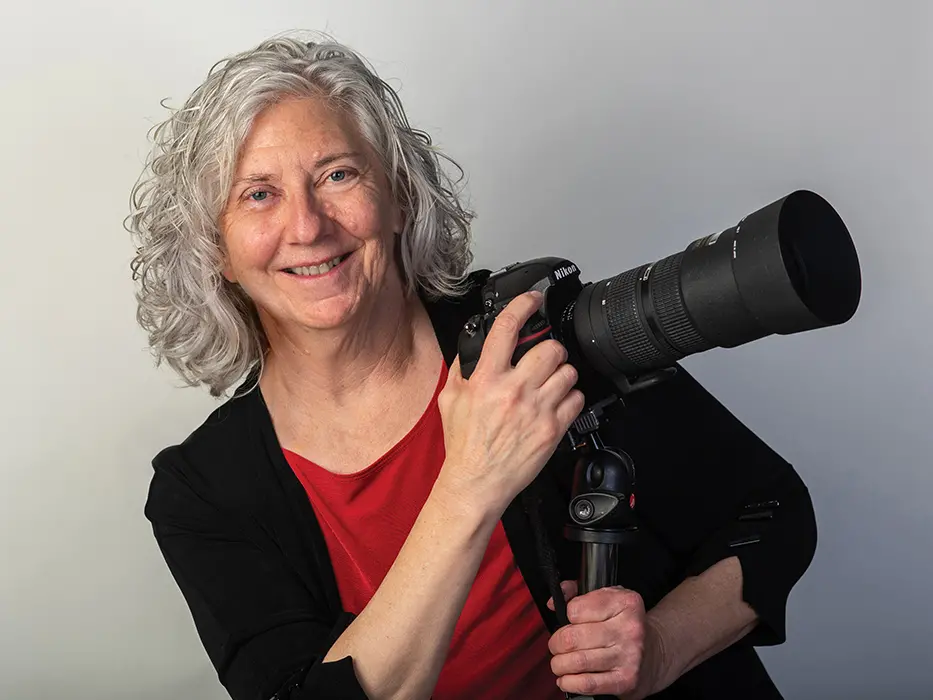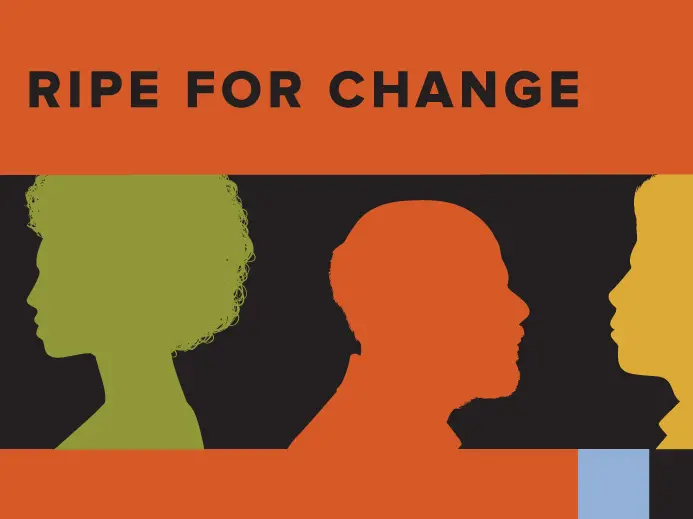A new campus landmark celebrates the Divine Nine
For Black fraternities and sororities, the long-awaited National Pan-Hellenic Council Plaza provides a welcoming space for students past, present and future.
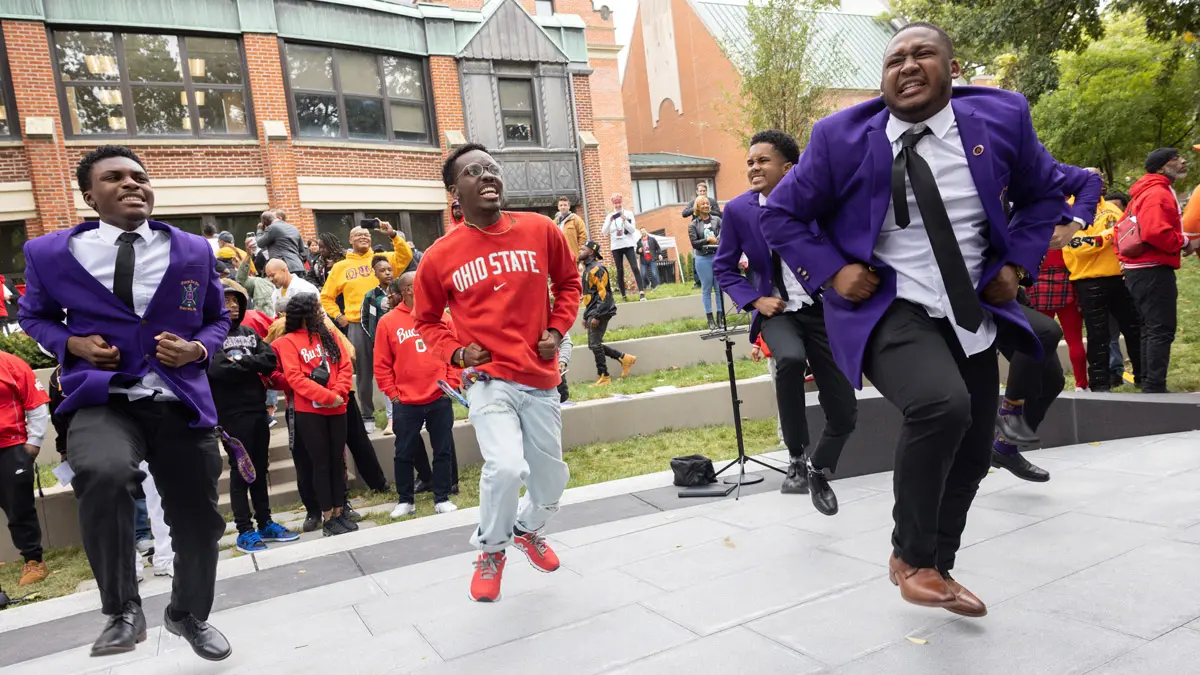
Omega Psi Phi Fraternity Incorporated members (from left) Quentin Mallory, Ryan Price, Austin Wilson (in back) and Daylan Jernigan dance at the plaza dedication in October.
A new landmark on South Oval pays tribute to the African American fraternities and sororities that have provided generations of Ohio State students and alumni with a sense of belonging and community.
The National Pan-Hellenic Council Plaza now stands behind Hale Hall, home of the Frank W. Hale Jr. Black Cultural Center and Office of Diversity, Equity and Inclusion, and along our campus’ historic Underground Railroad path. The dedication drew together hundreds of alumni, students, faculty and staff this fall.
Two prominent participants in the celebration were Larry Williamson Jr., who retired in March after 30 years as director of the Hale Center, and graduate student Rayonna Booth ’21, past president of Ohio State’s NPHC student organization and a driving force in the plaza’s establishment.
Here, Williamson and Booth talk about the hard work and collaboration that led to the plaza, which creates long-sought recognition for the “Divine Nine” fraternities and sororities, their members and the African American community as a whole.
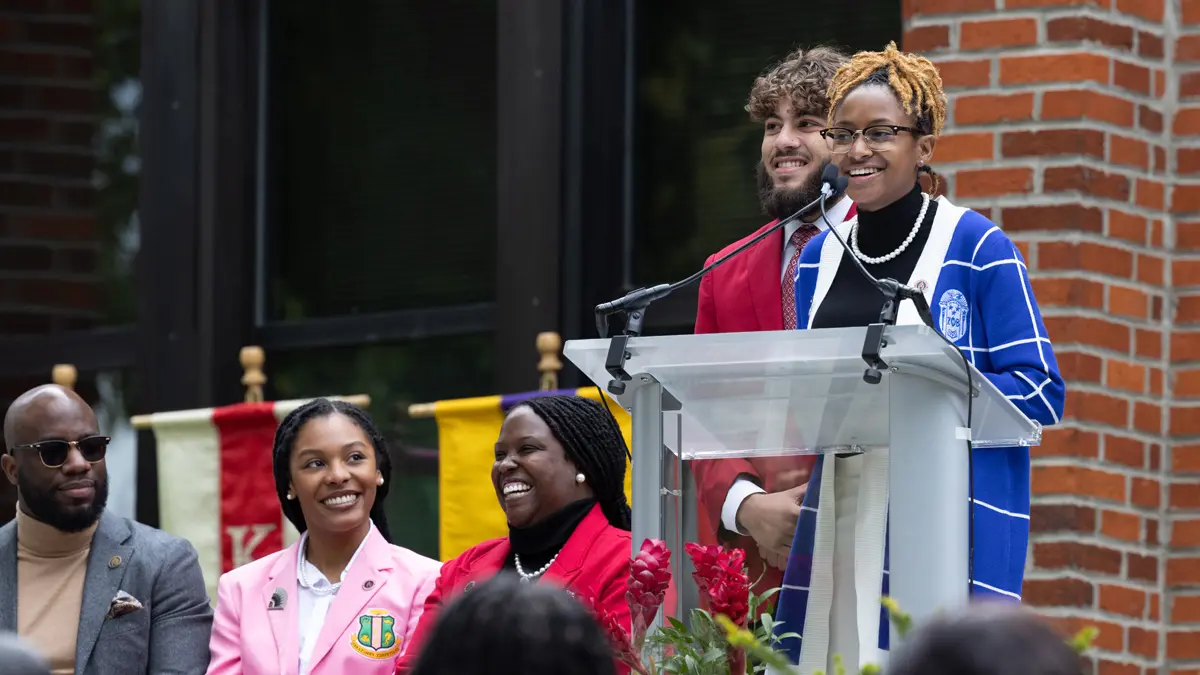
Alumna and graduate student Rayonna Booth, a key organizer of the NPHC plaza, addresses those gathered for the dedication.
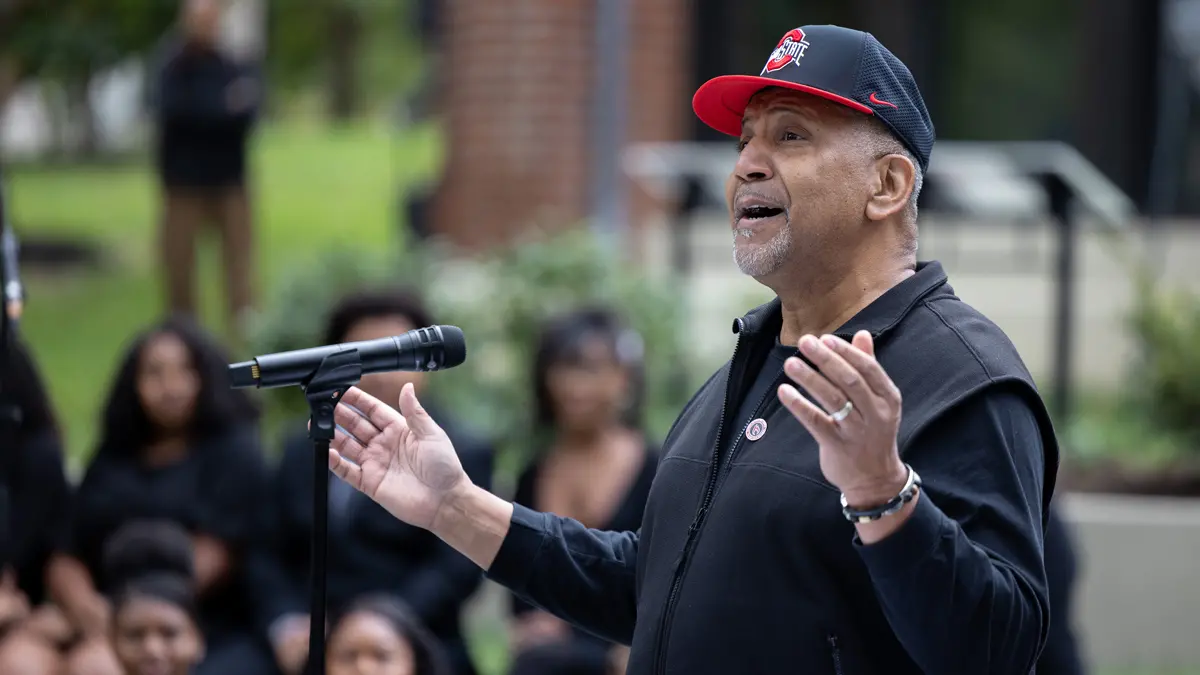
Larry Williamson, whose work as Hale Center director influenced three decades of students, receives a warm reception from the crowd.
Listen to the conversation
Conversation transcript
Rayonna Booth:
I’m Rayonna; some people call me Ray. I graduated from Ohio State in 2021 with my bachelor’s in health information management and systems. I am now a graduate student at Ohio State, getting my degree in public health. I know Mr. Williamson through many different ways. He’s been my boss in a sense, a mentor, a friend, and he allowed me to work at the health center as a freshman when I came here in 2017 and essentially built all of his student workers up to be leaders in the community and has always been one of the most honorable persons on campus, in my opinion.
Larry Williamson:
Hey. My name is Lawrence “Larry” Williamson Jr. I go by Larry Williamson, and many of the students call me Mr. Williamson. I was a former teacher and the way that I had to remember students was by their last name. It helps to establish leadership for them. And for our students, for them to be leaders, I would like to call them Mr. And Mrs., so therefore they get used to being called that.
I was director of the Hale Center. I was also curator of art for our center and collected artwork. The way that I got to know Ms. Booth, from her freshman year she was a dynamic student. She was a very vocal student. She was a Young Scholar at Ohio State University and we were very proud of her accomplishment. She was very serious from the degree of getting the job done, but at the same time very focused. She was a very good student at Ohio State University, and at the same time, she was very goal-oriented and I saw that from her first year.
This project was something that students looked forward to for the longest time. This is something that was historical. The question was, “Who could achieve this?” This was monumental to be able to achieve this, and it became a reality under her leadership, and it was a student movement continuously, but you had to have the right administration, the right leadership, the right people to make sure that it became a reality. And with her direction, with the right leadership of Ohio State University, it became magic. It became a reality, and I’m very proud.
Rayonna Booth:
Oh, thank you, Mr. Williamson. What would I do without you? Honestly, with Mr. Williamson being here, he’s honestly one of the biggest contributing factors to this whole thing. When I first became a member in Greek life, I remember him telling me, I’m going to do great things. I’m going to make some things happen.
Did I believe him at the time? I wasn’t sure. But when COVID started, there was all these things happening within the world, right? And black people specifically felt like they didn’t really have a voice in a lot of different areas of life. So a couple of us organized — me, Devon and Seneca — had a first meeting like, “This is something that we want to do.” I was the vice president at the time and we were in the midst of elections and Devon Stith was the incoming vice president at the time and we worked together. And Sabryn Davis-Cannon was also the president of the council at the time. So we all worked together, awesome team. And Seneca Crump was the advisor.
He was like, “Well, I think this is achievable.”
So I did all the benchmarking, the research from other Big 10 schools, seeing how they were able to come up with such projects and be able to accomplish this. How did they do it? Writing in all of our information, creating a proposal of the significance, why we need it, why it matters. And we happened to get a meeting with Dr. Shivers and she was new at the time. So when we threw this idea at her, she actually listened to us, and I think that’s where we got it going. She understood how serious we were about the project, how passionate we were about the project. And I think that’s important because if you’re not passionate and you’re not serious about something it’s not going to get done. And that led to a conversation with President Johnson and she was like, “We’re doing this project.” And we were like, “Oh my goodness, we can’t believe it.” I don’t think anybody had any words to say, we were just in shock because we know how long people have been fighting for a space on campus, specifically black people. So that’s kind of how it all started.
Larry Williamson:
I remember when Ms. Booth came to me, I mean, many students have come to me before and said, “We want to have a platform on campus to identify the accomplishment of our African American Greek organizations that have been on campus.” And I’m always going to be encouraging, but bottom line was, I was like, “Well, good luck.” Now, I’m not being a pessimistic because at Ohio State University, and specifically for the African American community, we’ve heard a lot of things that would happen at Ohio State. So therefore, depending on which administration that you’re dealing with, you hear things, and even for the Black community, the reality is, is it going to happen? So when it’s shared with me, I’m sitting there and saying, “OK, will it materialize?” Because I think that’s crucial.
They were excited. I was excited for them. I was excited that a president was going to stand behind it. I was excited that the vice president for Student Life was going to stand behind it. So it’s like, “Let’s see what happens beyond this point.” So when you start meeting and then your vice president, Dr. Shivers, is coming to those meetings and then they’re throwing out a budget, I’m like, “Oh! A budget’s being put out there. That’s tangible.” So that’s a big plus. And then you’re meeting biweekly and going over these things and you’re starting to go over everything. And then you’re bringing in project directors, project managers, to make sure that this thing is going to go. Then you have a timeline. Then you start to say, “OK, there’s a reality to this.”
Rayonna Booth:
Yeah, I think Dr. Shivers is a big key factor in all of this. She is the definition of a true leader. She kept in contact with Mr. Williamson, but she also kept in contact with me as I was graduating. I graduated in May and Devon was taking on my new position as the vice president in the NPHC, but she still made sure, “Hey, this project is going to happen. Do you want to attend some of these meetings? What do you think? How can you be involved now that you have graduated?” Right? Because most times when people graduate, they just leave it all behind and say, “OK, well I think I got it to work. I’m just going to let the next group figure it out.” And the type of person I am, I want to see it fully through. I want to make sure that it gets done. And Dr. Shivers, the communication was just all there.
Larry Williamson:
And then I had … Seneca left the university and he played a major role, but —
Rayonna Booth:
Major role.
Larry Williamson:
… you have to give Charity Martin-King a lot of credit too.
Rayonna Booth:
Oh, yes.
Larry Williamson:
… because she followed through a lot with that. And then Kim —
Rayonna Booth:
Kimberly Allen-Davis.
Larry Williamson:
… Davis, Allen-Davis did a good job from the alumni perspective of helping to pursue and to make sure certain things were done. So you had a community effort to make sure these things get achieved. And if we’re leaving people’s name out, it’s not intentional, but these are people that you know that still stuck with it to make sure that this thing got achieved and to the highest level.
Student Life did an exceptional job of making sure that information was there, that you could read through it. You had certain people from Student Life, you had a member or two from the Office of Diversity and Inclusion. So it was a collective effort just to make sure that people were aware of the things that were actually going on.
Rayonna Booth:
[On the day of the dedication] I woke up and I was like, “This day just can’t be real.” I don’t know. It didn’t really hit me yet. It still wasn’t realistic. Although I work in Hale Hall as a graduate student and I’ve been seeing them build it every day, working on it. It still did not seem real. But as I got to the Hale Center that morning and I sat in the Hale Library with Dr. Shivers, a few other people, someone from the board of trustees, Devon — it just hit us. I don’t know. We had a conversation about how this is really happening and all of us almost tearful, were tearful, and it didn’t really seem like it was a lot of people from looking through the window inside. But once we got outside, it just felt so overwhelming. I can just hear the drums were beating, people were loud, screaming like, “This is amazing.”
And I’m like, “Oh my goodness, I’m starting to tear up. I don’t believe this is happening right now.” Just to see alumni alone come back is just amazing because we need their support. And to see them come back and show up for this special dedication was just amazing, thrilling, all at one point. I didn’t really think a lot of alum would come back just because they have priorities now. They’re adults, adults, so they have maybe families now or jobs they couldn’t take off of. But people really came to support that day. And it made my heart feel very warm. But looking at the crowd and seeing them interact with each other like, “Oh my goodness, how you been? It’s so good to see you.” It was just like, we love each other. I’m glad that we love each other and it’s so good to be in a space, be in this space where we get to come back and see something that was thought of for years, but also embrace our presence of just being together as a family, in a sense.
Larry Williamson:
For myself, it was monumentous. I mean, it was homecoming, but it was homecoming from the perspective of having African American students come back, not only for the homecoming, but for a project that has come full circle and something that they always wanted. They invited me back to participate in that moment. To see so many students that I haven’t seen in such a long time and to be able to participate in the occasion was so thrilling to me. To have the president start off the occasion, to have the drumming, to show the real African culture and flavor of it, to be behind the Hale Center and Hale Hall was just so exciting. Then to see all of the Divine Nine participate. When you have a plaza of that magnitude, you’re feeling the spirit of all the people, all the Divine Nine, and all the people and all the feedback. You had the OSU 34 that were actually back there, it’s just not for the Divine Nine.
It’s a combination of all the African American people that sacrificed, that came to this university, for the ones that did not finish, for the ones that finished, for the ones that got graduates degrees. That’s a combination of everybody. It’s about leadership. I mean, that’s what NPHC, that’s what a Greek organization, it’s about service, it’s about leadership, it’s about education, it’s about academics.
I think it sets a standard of what Ohio State University can do when they put their mind to something and it shows the collective that can be done. And just never take our students lightly, that when our students put our mind to something and with their drive and with their commitment and their dedication, what can be achieved. I think it’s a great start of what students can really put their mind to doing. And I think it’s an excellent beginning that they can reach back from the past and say, “We can achieve this.”
And I think there’s so much more that our students can do when they can put their minds to it and look at the collective and say, “This is what we want to achieve. And there’s so much more that we can achieve when we come together as a group.”
Rayonna Booth:
Advocacy is very important. If you learn how to advocate for something and you’re passionate about it, you can get the job done. I’ve gotten a lot of feedback, “This is awesome.” “I’m glad you guys got this to go through.” “I never thought that this would happen.” “We’ve been working on this for years.” Some people even said, “Yeah, we just were like, ‘Call it quits,’ because it’s not happening. We’re never going to get this to happen.” And people were saying, “I’m just glad you guys carried out this vision and stayed determined in getting this thing done.”
And then there’s also some who said like, “OK, so what are we now going to do with the space?” So we have the space here. How is it going to be utilized? Is there going to be more seating added? Is there going to be any special lighting? Like what kind of programs are we going to have here? How can we truly embrace this space on campus?
My first thing that I told everybody is this is just the first step. So we have the ground laid here. Now it’s up to the undergrads now on how they’re going to utilize it. And if they ask for help on how should they utilize that. So I would just tell people, the undergrads now, they’re in control of the space. It’s also everyone else’s space, but they essentially control on what programs they can host there, what type of events, what community service acts. If they want to add something more to it, if they want to start planting flowers and things like that. It’s truly up to them. But they also have us as support, the D Nine family that will support them in bringing ideas as well. So if someone has an idea on how they can even make it a more better space or opportunities to bring to this space, that is also welcomed.
Larry Williamson:
I’ve never seen a point that at Ohio State that we have more than 4,000 African Americans on this campus. You have to look at how African Americans feel isolated at times at Ohio State University. You have a culture center, you have now the plaza, but there’s more things that African Americans need at The Ohio State University. We need to have also more vendors, African American vendors. We have an African American studies department that used to be one of the top in the nation. We need to make sure that we’re taking care of that and make sure it’s achieving its goal.
We had a strong office of diversity and inclusion. We need to make sure that that’s strengthened to the highest level. We have a very strong Black culture, so we make sure we got to take care of these. So we have initiatives that we’re looking for, but we got to make sure that we’re taking care of the initiatives and programs that we have and make sure that they’re strengthened. You have to have a climate that’s conducive for learning. If the climate is conducive for learning, a student will learn and learn very well, because Black colleges actually prove that.
Rayonna Booth:
That space is dedicated, again, to NPHC members specifically. And I stated earlier how it’s also a space for Black people, but also a space for Black students to see that things like this are achievable.
Larry Williamson:
And if it benefits African Americans, it benefits everybody. That space can be used for everybody. It’s like the Hale Center. The Hale Center is open to everybody, but it’s for African American students. If it benefits African American student, it benefits everybody.
Rayonna Booth:
Yeah. Everybody utilizes it. I see people walking on the plaza to this day of any race, just viewing like, “Oh my gosh, what is this?” It’s an educational resource.
We have a lot of tours from potential students who will be attending Ohio State. And I know a lot of things that draw people away from predominantly white institutions is not seeing the presence of Black students or Black initiatives or African American culture. But that is a landmark now, when they do their tours, they’ll see Hale Hall and they’ll see this plaza and a tour guide will be able to tell them what that is, who it is for, to draw more students in to actually want to come to Ohio State.
Because when I first came here, I was like, “Oh no, where are the Black students?” It’s a big cultural shock coming from the communities that most of us come from. So it’s like, if I feel like I can be here, there’s a presence for me here. And I can see that, oh, they have a place for Black people. Oh my goodness, that’s cool. Let me see how I can get involved. This is nice. This Big 10 school has this? Wow. Yeah.
Larry Williamson:
That’s crucial. “How do I fit in?” And I think that’s crucial. And, “How am I a part of this major campus?” And, “How am I a part of this great university?” And I think that’s key for African American students, and any students, and students of diversity, to go and say, “What was my landmark at Ohio State University? What did you accomplish at Ohio State University?” ‘Cause that’s key to what you’re going to do for the future. When Ms. Booth leaves Ohio State University, she knows that she established something here. Now what will she establish in the world as she goes? Because she achieved it at Ohio State University. If you achieved it at Ohio State University, you can achieve it at any place in the world.
Rayonna Booth:
Yeah. I remember that’s one of the first questions Mr. Williamson ever asked me before I even became a member in Greek life is, “What legacy are you going to leave here on campus?” And I honestly didn’t know. I didn’t know what that meant for me. But me being a person who is so community driven, after I became a member in the Greek organization, I finally found my purpose on what I am drawn to do. And that is advocate for things for Black students. We don’t want Black students to feel like they’re alone on campus. We want them to feel like they have a safe space, a home to always just come back to, to go to, to realize that, “I do belong here.”
It’s one thing to say, “This is a place where you belong.” Right? But belonging is an action. You have to actually feel that. You can’t just say, “This is a space for that.” So that space specifically has to be used in a way where it will make Black people feel welcomed. The space is there, now how the students utilize it is what matters.
Larry Williamson:
I applaud the university for its diversity initiatives. I think that is very, very key. And sometimes when you have diversity, it breeds competition. And unfortunately, you don’t want to have competition. You want to be able to sing the praises of a community that needs it. And each group has a need. And I think this plaza is a need that needed to be addressed. The African American community has more needs that need to be addressed. The Hispanic community has more needs that need to be addressed. The Asian community has more needs that need to be addressed. We need to get away from the competition and have each community that comes across here say, “Let’s address our needs.” Our gay and lesbian community has needs that need to be addressed.
Rayonna Booth:
It’s visibility. That was one of the goals of that project was to promote visibility. You see all of the other sorority and fraternity life, like IFC and PHA, how they have all these wonderful, beautiful houses on campus and we don’t have those. Majority of the fraternities and sororities in the Divine Nine focuses on scholarships, sisterhood or brotherhood, and community service of some sort. So that first scholarship meaning is just keeping our community on their toes about scholarship, their grades, being involved, and just truly focusing on their academics so that they can reach that goal and milestone of graduation.
Second, the brotherhood, sisterhood is making sure we can bring together a community where we can rely on one another, hold each other accountable and things of that nature. And then you have community service, which is something all of our organizations do, even as a council they host community service events. We were on campus doing the work for the community, helping in any way that we can. All of our D Nine organizations put in work like no other. And it goes unseen. No one knows that we exist, but now we have a place that is so visible you can’t miss it. So it’s like, who are these organizations? What do they do? Ultimately we can tell them what we do, and how we operate, and the things we can bring to the community.
The council of 2019 and 2020, truly amazing. We had a really small council of about 33 people, which now the council was like maybe 60-plus people. And together as a council, I mean, we did it. I would say our council is the one who actually made this happen. I love them. And I would just say we’re the best council out there, especially Seneca Crump, our advisor at the time, is really the person who motivated and pushed us to make it happen. Because truly without him, it would not be here. You also need someone who is a good advisor to the students, to want to push them to do more and to be better. So I do truly appreciate Seneca and the 2019-2020 Council.
If you want to see something done, you have to keep going after it. So I found something that meant something to me that I wanted to see happen, along with a few others. And it just really takes that dedication of not giving up, because it can be so hard to say, “Well, they’re not listening to me. It can’t be done. We don’t know who to talk to.” OK, if I don’t know who to talk to, let me talk to this person to see if they can get me a connection to this person. So not stopping, basically, is the moral of the story. If I want to see something done, I’ll get it done. So it’s just taught me to have that enthusiasm to just keep going, even if it feels like it can’t be done.
Larry Williamson:
I applaud you and the council tremendously.
Rayonna Booth:
Thank you, Mr. Williamson. I applaud you.
The plaza recognizes the contributions of the nine national fraternities and sororities that make up the NPHC. Represented are:
- Alpha Phi Alpha Fraternity, Incorporated
- Alpha Kappa Alpha Sorority, Incorporated
- Kappa Alpha Psi Fraternity, Incorporated
- Omega Psi Phi Fraternity, Incorporated
- Delta Sigma Theta Sorority, Incorporated
- Phi Beta Sigma Fraternity, Incorporated
- Zeta Phi Beta Sorority, Incorporated
- Sigma Gamma Rho Sorority, Incorporated
- Iota Phi Theta Fraternity, Incorporated
Some of the many participants in the October dedication ceremony share their perspectives here.
Larry Williamson Jr., retired director of the Hale Center: “When you have a plaza of that magnitude, you’re feeling the spirit of all the people, all the Divine Nine, the OSU34 — all the people. It’s a combination of all the African American people that sacrificed — that came to this university, for the ones that did not finish, for the ones that finished, for the ones that got graduate degrees. That’s a combination of everybody. It’s the spirit of our community.”
Rayonna Booth ’21, an NPHC Plaza student coordinator: “We don’t want Black students to feel like they’re alone on campus. We want them to feel like they have a safe space, a home to always come back to. It’s one thing to say, ‘This is a place where you belong.’ But belonging is an action. You have to actually feel that. The space is there. Now, how students utilize it is what matters.”
Ohio State President Kristina M. Johnson: “Although Ohio State was always open to all persons, it unfortunately did not mean we welcomed everyone. So, born of exclusion and created to give Black students a safe space to thrive, the Divine Nine emerged as a powerful and unifying force whose importance to society transcends time. From this day forward, the history and legacy of our Black Greek organizations will be commemorated as part of the physical landscape of The Ohio State University.”
Reginald “Reggie” A. Wilkinson ’72, ’73 MA, Ohio State trustee: “This plaza is open to the entire university. I know firsthand the transformation that can come to life when we follow our [Phi Beta Sigma Incorporated] principles of brotherhood, scholarship and service. I’m proud to make sure this multifunctional space is one we can all enjoy.”
Senior Vice President for Student Life Melissa Shivers: “We know that for some of you, this is one of the very first times you have been engaged with the university in some time. All of you, as alums, made today possible. Without your fight, without your struggle, without your continued commitment to these students, we could not be here. So thank you for everything you have given to this place, and thank you for coming back home.”
